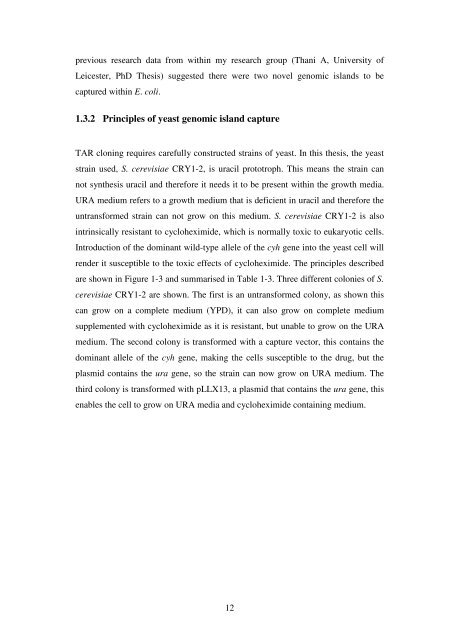5 The role of quorum-sensing in the virulence of Pseudomonas ...
5 The role of quorum-sensing in the virulence of Pseudomonas ...
5 The role of quorum-sensing in the virulence of Pseudomonas ...
Create successful ePaper yourself
Turn your PDF publications into a flip-book with our unique Google optimized e-Paper software.
previous research data from with<strong>in</strong> my research group (Thani A, University <strong>of</strong><br />
Leicester, PhD <strong>The</strong>sis) suggested <strong>the</strong>re were two novel genomic islands to be<br />
captured with<strong>in</strong> E. coli.<br />
1.3.2 Pr<strong>in</strong>ciples <strong>of</strong> yeast genomic island capture<br />
TAR clon<strong>in</strong>g requires carefully constructed stra<strong>in</strong>s <strong>of</strong> yeast. In this <strong>the</strong>sis, <strong>the</strong> yeast<br />
stra<strong>in</strong> used, S. cerevisiae CRY1-2, is uracil prototroph. This means <strong>the</strong> stra<strong>in</strong> can<br />
not syn<strong>the</strong>sis uracil and <strong>the</strong>refore it needs it to be present with<strong>in</strong> <strong>the</strong> growth media.<br />
URA medium refers to a growth medium that is deficient <strong>in</strong> uracil and <strong>the</strong>refore <strong>the</strong><br />
untransformed stra<strong>in</strong> can not grow on this medium. S. cerevisiae CRY1-2 is also<br />
<strong>in</strong>tr<strong>in</strong>sically resistant to cycloheximide, which is normally toxic to eukaryotic cells.<br />
Introduction <strong>of</strong> <strong>the</strong> dom<strong>in</strong>ant wild-type allele <strong>of</strong> <strong>the</strong> cyh gene <strong>in</strong>to <strong>the</strong> yeast cell will<br />
render it susceptible to <strong>the</strong> toxic effects <strong>of</strong> cycloheximide. <strong>The</strong> pr<strong>in</strong>ciples described<br />
are shown <strong>in</strong> Figure 1-3 and summarised <strong>in</strong> Table 1-3. Three different colonies <strong>of</strong> S.<br />
cerevisiae CRY1-2 are shown. <strong>The</strong> first is an untransformed colony, as shown this<br />
can grow on a complete medium (YPD), it can also grow on complete medium<br />
supplemented with cycloheximide as it is resistant, but unable to grow on <strong>the</strong> URA<br />
medium. <strong>The</strong> second colony is transformed with a capture vector, this conta<strong>in</strong>s <strong>the</strong><br />
dom<strong>in</strong>ant allele <strong>of</strong> <strong>the</strong> cyh gene, mak<strong>in</strong>g <strong>the</strong> cells susceptible to <strong>the</strong> drug, but <strong>the</strong><br />
plasmid conta<strong>in</strong>s <strong>the</strong> ura gene, so <strong>the</strong> stra<strong>in</strong> can now grow on URA medium. <strong>The</strong><br />
third colony is transformed with pLLX13, a plasmid that conta<strong>in</strong>s <strong>the</strong> ura gene, this<br />
enables <strong>the</strong> cell to grow on URA media and cycloheximide conta<strong>in</strong><strong>in</strong>g medium.<br />
12














